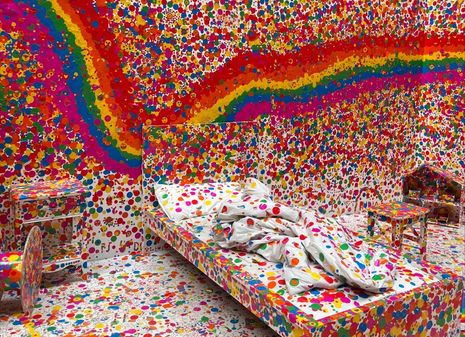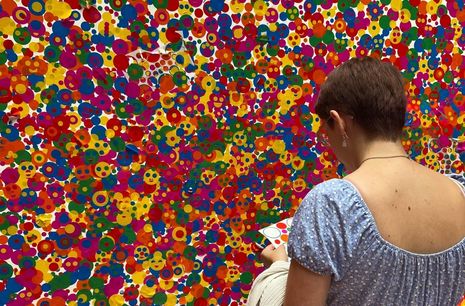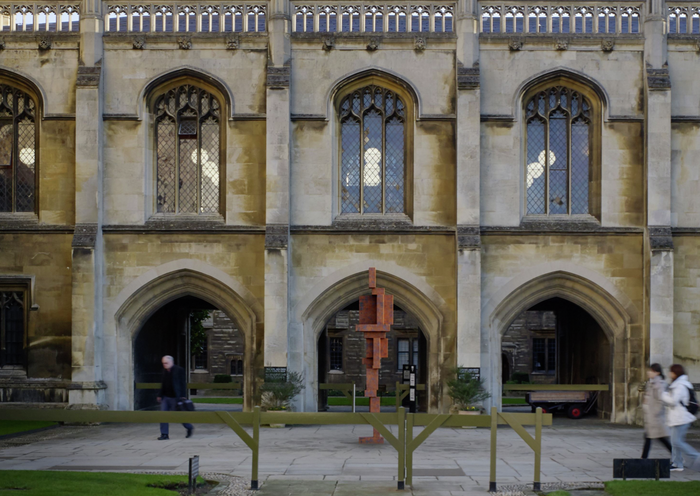‘The joy of this exhibit is how much it invites play’: the Obliteration Room at the Tate Modern
This summer’s Turbine Hall exhibition asked visitors to cover a white apartment in coloured dots. It’s genius lies in removing the gap between art and onlooker

First staged in the Queensland Art Gallery in 2002, Yayoi Kusama’s “Obliteration Room” has been on display at the Tate Modern this summer, in partnership with the Japanese retail brand UNIQLO as part of the “UNIQLO Tate Play” project at the gallery.
The exhibit begins its life as an entirely white space: a monochromatic home with a lounge, kitchen, bedrooms and playroom. The aim is for visitors to completely transform the space through their own creative choices, by placing circular stickers wherever they desire; the artistic creation is entirely placed within your hands. The one rule is that you use all the stickers you’re given within the space.
By the time I visited in late August, there was little white left. The majority of the white was concentrated in the final room. But this white was not from Kusama’s apartment, rather it was created from the sticker sheets left from people’s “obliteration”, forming a carpet across the space.
It was primarily designed with children in mind
Kusama has repeatedly used the dot motif across her career. However, here she hands us her medium in the form of a sheet of dot stickers. She asks us to engage with it and to allow our creativity to flow through it. Patterns emerge, wherever you look, whether purposeful or accidental, in the ways people have chosen to use their stickers. A personal favourite of mine was people’s tendency for creating faces with little “o” shaped mouths on the mirror (which I added my own to).
There are also large arching, swooping rainbows in every room. The rainbows appear to wrap around the entire apartment in a bow when the exhibit is viewed in its entirety from the balcony, becoming the only discernible feature when viewed this way. All the other interior objects in the house are absorbed into the mix of colour, as you are hit by an explosion of colour surrounding you on all sides. I wonder who began the rainbows. What forces allowed them to, repeatedly, yet organically, spring up and grow across the entire summer of this project?

The primary joy of this exhibit is how much it invites, and centres on, play. It was primarily designed with children in mind. But it also indulges a child-like desire in adults to scribble all over the walls, handing back a kind of creative freedom. The exhibit aims to bring colour to everything. It aims to inspire communal artistic creation both within the space and within our lives more generally. The promotion of art in our own worlds is stressed through the domestic setting of the blank canvas.
The Tate’s brutalist architecture is also transformed via this colourful exhibit
Play is encouraged not only through the premise of the exhibit, but also by having a final room full of toys. This room includes a rocking horse, a ping pong table, and a piano whose dots are worn from repeated playing. The clunks of the piano reverberate around the whole space– its echoes adding to the overpowering sensory experience of the exhibit. Upon entering the apartment, the area commands your whole body, creating a fully immersive and physical experience.
The Tate’s brutalist architecture is also transformed via this colourful exhibit: both literally through its colour and through the spirit of its idea that art should be joyful, collaborative, and spread beyond boundaries. There is no frame here, no segregated distance between art and onlooker, no detachment between the artistic process and the final piece. Everything is there, present in your own hands and beneath your feet.
Often Kusama’s exhibitions aim to draw the viewer into her obsessive vision of an endless sea of dots. Here, she asks us to represent ourselves in the dots, to enact the creation of the way she sees the world. In a similar vein, her exhibits often deal with the notion of infinity by existing in a space which has an element of endlessness.
While the Obliteration Room exhibition has come to an end at the Tate Modern, Kusama’s other immersive installation, Infinity Mirrors, is currently still on display there. For students yearning for the Fitzwilliam and looking for exhibits to explore over the summer, these displays are the perfect opportunities to experience Kusama’s world.
 News / Clare Hall spent over £500k opposing busway 24 December 2025
News / Clare Hall spent over £500k opposing busway 24 December 2025 Comment / The ‘class’ of Cambridge24 December 2025
Comment / The ‘class’ of Cambridge24 December 2025 News / Caius mourns its tree-mendous loss23 December 2025
News / Caius mourns its tree-mendous loss23 December 2025 Comment / League tables do more harm than good26 December 2025
Comment / League tables do more harm than good26 December 2025 News / Girton JCR publishes open letter expressing solidarity with Palestine25 December 2025
News / Girton JCR publishes open letter expressing solidarity with Palestine25 December 2025









